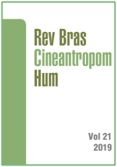Teste de potência e agilidade no NBA pre-draft combine
DOI:
https://doi.org/10.1590/1980-0037.2019v21e59838Resumo
O objetivo deste estudo foi examinar as associações entre os escores de desempenho dos atletas no Pre-Draft Combine da NBA. Foram examinados os desempenhos de 480 atletas nas avaliações do Pre-draft Combine da NBA de 2010 a 2017. Os testes do Draft Combine considerados incluíram o Shuttle Run Test, o Lane Agility Test, o Sprint Test e o Jump Test (salto vertical em pé). Correlações de ordem zero foram calculadas para examinar as associações entre os testes de desempenho através da adequação de modelos de regressão linear Bayesiana. Entre os testes de corrida, tanto o teste Shuttle Run (r = 0,45, intervalo de confiança (IC) de 95% 0,34 a 0,56) e teste de Sprint (r = 0,45, IC 95% 0,37 a 0,54) foram moderadamente associados com o Teste Lane Agility. A associação entre o Sprint Test e o Shuttle Run Test foi de moderada para alta (r = 0,27, IC 95% 0,16 a 0,38). As correlações entre o Teste de Salto e os testes de corrida foram de moderada a grande, variando de -0,51 a -0,19 (Lane Agility Test: r = -0,33, IC 95% -0,42 a -0,24; Teste Shuttle Run: r = -0,19, IC 95% -0,31 a -0,07; Teste de Sprint: r = -0,51, IC 95% -0,59 a -0,43). Assim, foi verificado uma correlação de moderada a grande entre o desempenho dos testes do Draft Combine da NBA, o que indica que os procedimentos gerais podem fornecer, parcialmente, informações sobrepostas sobre o desempenho máximo de curto prazo do basquetebol.Referências
Sullivan C, Kempton T, Ward P, Coutts AJ. Factors associated with early career progression in professional Australian Football players. J Sport Sci 2018;36(19):2196-201.
Teramoto M, Cross CL, Rieger RH, Maak TG, Willick SE. Predictive Validity of National Basketball Association Draft Combine on Future Performance. J Strength Cond Res 2018;32(2):396-408.
Foran B, Pound R. NBCCA: Complete conditioning for basketball. Champaign, IL: Human Kinetics; 2007.
Wen N, Dalbo VJ, Burgos B, Pyne DB, Scanlan AT. Power testing in basketball: Current practice and future recommendations. J Strength Cond Res 2018;32(9):2677-91.
Mcgee KJ, Burkett LN. The National Football League combine: a reliable predictor of draft status? J Strength Cond Res 2003;17(1):6-11.
Kuzmits FE, Adams AJ. The NFL combine: does it predict performance in the National Football League? J Strength Cond Res 2008;22(6):1721-7.
Robbins DW. The National Football League (NFL) combine: does normalized data better predict performance in the NFL draft? J Strength Cond Res 2010;24(11):2888-99.
Team SD. Stan: A C++ Library for Probability and Sampling; 2015. Avaliable from: https://mc-stan.org/ [2018 jun 23].
McElreath R. Rethinking: an R package for fitting and manipulating Bayesian models. Version 1.56; 2016. Avaliable from: http://xcelab.net/R/rethinking_package.pdf [2018 jun 23].
McElreath R. Statistical rethinking: a Bayesian course with examples in R and Stan. Boca Raton, FL: Chapman & Hall/CRC Press; 2015.
Team RC. R: A Language and Environment for Statistical Computing. Vienna, Austria: R Foundation for Statistical Computing; 2015.
Berri DJ, Brook SL, Fenn AJ. From college to the pros: Predicting the NBA amateur player draft. J Prod Analysis 2011;35(1):25-35.
Rodenberg RM, Woo Kim J. Precocity and labor market outcomes: evidence from professional basketball. Econ Bull 2011;31(3):2185-90.
Moxley JH, Towne TJ. Predicting success in the national basketball association: Stability & potential. Psychol Sport Exerc 2015;16(1):128-36.
Hoffman JR, Tenenbaum G, Maresh CM, Kraemer WJ. Relationship between athletic performance tests and playing time in elite college basketball players. J Strength Cond 1996;10(2):67-71.
Lowe Z. Grantland: a whole new ballgame; 2012. Available from: http://grantland.com/features/what-next-trend-sweep-nba/ [2018 jul 03].
Downloads
Publicado
Edição
Seção
Licença

Direitos Autorais para artigos publicados nesta revista são do autor, com direitos de primeira publicação para a revista. Em virtude da aparecerem nesta revista de acesso público, os artigos são de uso gratuito, com atribuições próprias, em aplicações educacionais e não-comerciais, desde que seja dada a atribuição. Esta obra foi licenciada com uma Licença Creative Commons Atribuição 4.0 Internacional - CC BY


